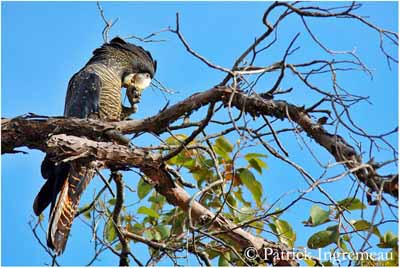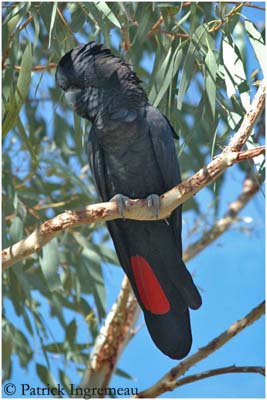
Red-tailed Black Cockatoo
Calyptorhynchus banksii
Psittaciforme Order – Cacatuidae Family
BIOMETRICS:
Length: 60-65 cm
Weight: Male: 670 - 920 g – Female: 615 - 870 g
LONGEVITY: About 100 years
DESCRIPTION:
Red-tailed Black Cockatoo is a large black cockatoo endemic to Australia.
Adult male has black plumage, with conspicuous bright red subterminal patches in lateral tail feathers.
On the head, a prominent crest is recumbent on crown and nape, but it raises it when alarmed or excited.
Strong bill is blackish. Eyes are black with dark grey bare eye-ring. Legs and feet are dark pinkish-grey.
Female lays one egg, sometimes two. But only one chick is raised. Incubation lasts about 28 to 30 days, by female alone. She is fed by male during this period. Both parents feed the chick. This one, as other black cockatoo chicks, is covered with fairly long yellow down. Young depends on its parents for about 3 months for food. It may fledge at 100 days of age, and it got the adult size.
DIET:
Red-tailed Black Cockatoo feeds mainly on seeds, but it also consumes fruits, nuts, flowers, bulbs and insects. It can feed in tree canopy and on the ground.
PROTECTION / THREATS / STATUS:
Red-tailed Black Cockatoo is widespread in drier parts of Australia, but subspecies “graptogyne” and “naso” are endangered because their numbers are low, geographic range is small and isolated, and their diet is specialized. Their range is fragmented and threatened by deforestation. These birds have also been the subject of illegal trade. They are the most often seen in captivity.
The National Recovery Plan for the Red-tailed Black Cockatoo wishes to maintain feeding and nesting areas and protection against nest predators, in order to protect species and subspecies.
Red-tailed Black cockatoo is named in honour of the scientist Sir James Banks.
Fr: Cacatoes banksien
All : Rabenkakadu
Esp : Cacatúa Colirroja
Ital : Cacatua nero codarossa
Nd : Roodstaartraafkaketoe
Russe : Рыжехвостый черный какаду
Photographs byPatrick Ingremeau
TAMANDUA
Text by Nicole Bouglouan
Sources:
HANDBOOK OF THE BIRDS OF THE WORLD volume 4 by Josep del Hoyo, Andrew Elliot and Jordi Sargatal – LYNX EDICION – ISBN 8487334229
PARROTS OF THE WORLD – An Identification Guide – by Joseph M. Forshaw – Princeton University Press – ISBN 0691092516
Wikipedia (Wikipedia, The Free Encyclopedia)

Female is brownish-black. She has yellow small spots on head, crest and shoulders. Underparts show pale orange-yellow barring. Undertail is barred with orange-yellow stripes. Bars become narrower towards tail tip. Female has smaller crest. Strong bill is pale grey, paler than in male.
Juvenile resembles female and reaches its sexual maturity at 4 years.
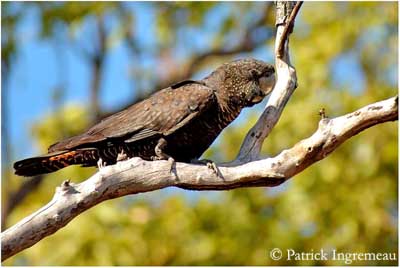
There are five subspecies with different sizes. We can find two major groups where each female shows differences in plumage.
C.b.banksii: male has red band across lateral tail feathers. Female and juvenile have orange-yellow barring in centre of lateral tail feathers. They live in north-eastern Australia.
C.b.macrorhynchus: male has broader and heavier bill. Female and juvenile have pale yellow bearing on lateral tail feathers, no orange. They live in northern Australia.
C.b.samueli: adults and juvenile as “banksii”, but they are smaller, with smaller bill. There are four isolated populations, from west coast to south eastern Australia.
C.b.graptogyne: adult male is similar to “samueli”. Female and juvenile are more brightly marked than “samueli”. They live in south western Victoria. It is an isolated endangered population.
C.b.naso: adult male is similar to “samueli” with wings appearing long and pointed. Crest is shorter and more rounded. Bill is larger and broader. Female and juvenile are more heavily spotted and barred with brighter yellow. They live in south-western Australia. It is near-threatened.
VOICE: SOUNDS BY XENO-CANTO
Red-tailed Black Cockatoo gives a rolling, metallic “kree-ee” or “krur-rr” in flight, a kind of trumpeting tone, carrying far. It also utters soft growling or quavering “krow-row”. When alarmed, it gives a sharp “krur-rak”.
HABITAT:
Red-tailed Black Cockatoo lives in forest and open country. It favours Eucalyptus woodlands and trees along rivers, but it can frequent wide variety of habitats, such as subtropical rainforest, grasslands with scattered trees or farmlands with scattered Eucalyptus.
RANGE:
Red-tailed Black Cockatoo is native to Australia and widespread in drier parts of Australia. They are more abundant in the north of the country.
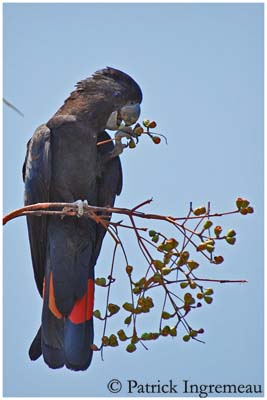
BEHAVIOUR:
Red-tailed Black Cockatoo feeds mainly on seeds. When feeding in flocks, we can hear the noise coming from their bills breaking the shells in order to get the seeds. When they feed in savannah, they search for food in flocks of up to 100 birds, and they are very noisy and conspicuous.
When living in wooded areas, they are rather seen in pairs or in small family groups.
They leave their communal roost in the early morning for drinking at regular place, and they disperse widely to feeding areas. In the middle of the day, they remain sheltered into foliage, and return to feeding areas in the late afternoon. At the end of the day, the flock returns to the roosting trees near water.
In northern and central Australia, species feed as in trees or on ground. Southern species are mostly arboreal.
Northern populations of Red-tailed Black Cockatoos perform some seasonal movements, whereas in south, movements depend only on food resources.
Red-tailed Black Cockatoo erects its crest when it alights or when alarmed or excited. Male performs some displays, singing and strutting along a perch, ending in a jump which displays the red tail feathers towards female. She replies by biting it defensively.
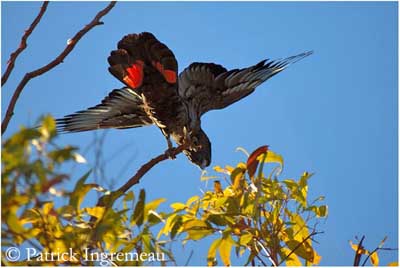
FLIGHT:
Red-tailed Black Cockatoo has strong, buoyant flight, with deep, flapping wing beats. When flying above trees, it drops down to feed, gliding with motionless, down curved wings, for hundreds metres. They can perform long distance flights at considerable height.
REPRODUCTION:
Breeding season occurs from March to September in the north, and from July to October in the west. Red-tailed Black Cockatoo mates for life and if one of the birds disappears, the other may not mate again.
Red-tailed Black Cockatoo nests in hollows in trees or in dead trees too, and it requires tall trees. Usually, the nest is situated at about 15 metres above the ground. The hollow is lined with chewed and decayed wood.
